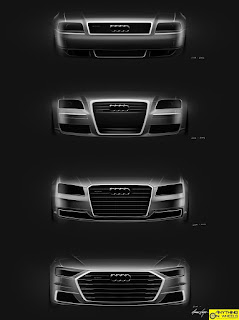Mercedes-Benz announced their much-awaited foray into the lucrative world of pick-up trucks, the first from a luxury car-manufacturer, with the X-Class making its global debut in Cape Town, South Africa last week.
Following its unveiling as a concept in 2016, expectations around the 'Mercedes of pick-ups' were building up leading to the vehicle's debut. That wasn't a least bit surprising. Here was Mercedes-Benz aiming to combine the robustness, functionality and off-roading abilities we normally associate with a pick-up with the design, comfort and safety that the three pointed star is known for. Sounds perfect, right?
Now that the X-Class has been unveiled and the specifications are out, it's time to get our heads down and find what's good and what's not. Read on.
The Good
When the Concept X-Class was unveiled at Stockholm last year, it left a lasting impression on account of its styling amongst other things. In its production form, the X-Class is obviously a bit toned down and more mainstream. Its neither as plush as the Stylish Explorer nor as hardcore as the Powerful Adventurer, the two distinct trims showcased in concept form. But that doesn't take anything away from yet another impressive work done by the design team at Mercedes-Benz. The Stuttgart-based brand has been going through a design-led transformation over the past few years and the X-Class is another fine feather added to their caps.


The large twin-louvre grille adorned with the three pointed star, the peeled-back headlamps with the characteristic 'Mercedes' pinch on the insides and the high bonnet give the X-Class a typical Mercedes SUV look. Parked next to a GLC or GLE, the X-Class wouldn’t look out of place like most feared it would. The profile stays honest to the vehicle's origins with a raked-up rear window that’s possibly the only visual clue about the X-Class’ association with the Nissan Navara. Here again, Mercedes-Benz have done their bit with flared, squared-up wheel arches that impart a dynamic and rugged stance. The rear is relatively plain jane with the LED-equipped taillight clusters sprucing things up a bit. Think of it, the slim wrap-around LED strip like the one we saw in the Stylish Explorer Concept would have made a world of difference here, making the X-Class stand out. Our wishful thinking apart, Mercedes-Benz has got the look, feel and stance of the X-Class just right. There are no complaints here.
The Bad
The Mercedes-Benz X-Class is not destined to go on sale in the United States of America. Instead, the X is headed to Europe by the end of the year. South Africa, Australia and New Zealand would follow next in 2018 while Argentina and Brazil are likely to lay their hands on the truck beginning 2019.
Sounds like sacrilege, doesn't it? After all, the US of A is the biggest market for these vehicles and the top-selling vehicle there for the last 35 years, the Ford F-Series, was one of the products Mercedes-Benz claims to have benchmarked while developing the X-Class. Before you go crazy asking "What were they thinking?", know that as much as Americans love pick-ups, they like their trucks full-size. The X-Class classifies as a mid-size truck, sales of which are just a fraction of the big-selling full-size trucks from Ford, GM and Chrysler. Moreover, the folks at Mercedes-Benz would have also taken note of the fact that Toyota, Honda and Nissan have been trying in vain to make an impact in this segment for decades. What chance would a new-comer to the segment have, the premium image notwithstanding?
While we do sort of get our head around the decision taken by Mercedes-Benz, we feel the X-Class, in some form or the other, will be headed to the states at some point in future. You just can't have a pick-up in your portfolio and not sell it in the United States. Period.
The Good
When Mercedes-Benz made their intentions to make a pick-up public, there were contrasting view points as one would expect when such out-of-the-box decisions are made. While the potential for such a vehicle in wealthy show-off markets like the Middle East was undeniable, there were also deliberations on why the German luxury marque should leave the job of making pick-ups to the American car-makers who arguably make the best pick-ups in the market and how they could end up shooting themselves in the feet by trying to challenge established offerings from rivals with a wannabe truck at an inflated price.
By launching the X-Class in three different trim levels targeted at specific demographics, those critics have been partially silenced.
The ‘Pure’ trim level is aimed at the core set of customers that buy these vehicles for their ruggedness and load-carrying ability. You never thought you would see an utilitarian Mercedes-Benz with unpainted plastic bumpers and wheel caps, did you? At least, we never did. At the other end, there is the ‘Power’ variant that’s aimed primarily at the urban-dweller who needs a lifestyle vehicle. With classy chrome embellishments and additional creature comforts inside, it makes quite an impression.
Point is, the folks from Germany seem to have done their homework pretty well.
The Bad
As much as Mercedes-Benz would not acknowledge, fact is the X-Class is a humble Nissan Navara underneath. Of course, Mercedes-Benz has made sure you don't see its origins in the flesh but what stopped them from going the full distance and develop an all-new truck from scratch?
One reason is obviously the millions of Euros they would have had to spend. But, aren't Daimler's pockets deep enough to spend on what could be a potential game-changer for the brand? If anything, Mercedes-Benz stood the best chance amongst all luxury car-makers to invest on the first-ever premium pick-up and get it right, given the years of legacy they enjoy with their vans and commercial vehicles. But then, if this platform-sharing would help Mercedes-Benz focus and spend more on the C-, E-, S- and their derivatives, we aren't complaining.
That said, the Navara underpinnings mean the X-Class' hardware is robust and capable to do what pick-ups are supposed to do, both on and off-road.
The Good
This might be Mercedes' first-ever pick-up but they seem to have got the specs right, balancing the requirements of the segment and their own brand image.
The cabin looks like a Mercedes alright but it also appears to be rugged enough to withstand abuse. The free-standing central display with the 8.4-inch screen is the biggest in segment while the characteristic circular air-conditioning vents lends a touch of class. Features you normally do not expect on a pick-up, the likes of multifunctional touchpad in the center console that can be controlled using gestures, ARTICO leather upholstery with lavish top-stitching, a full safety suite including seven airbags, Active Brake Assist, Lane Keeping Assist, Traffic Sign Assist, Trailer Stability Assist and Tyre Pressure Monitoring System, real-time Live Traffic Information and comfort-oriented suspension with coil springs at the front and rear, the X-Class stays true to the phrase 'the Mercedes of pick-ups'.
The Not so Good
The X-Class is not your regular Mercedes saloon, we get that. Yet, there is no denying the fact the engines on offer in the truck could have been more exciting to satisfy our never-ending power-cravings.
To start with, there are two four-cylinder engines powering the lineup. The 2.3-liter common-rail diesel engine generates 163 horsepower in the X 220 d and 190 horsepower in the X 250 d. Select markets will have the X 200 with a 165 horsepower petrol engine. The base engines are mated to a 6-speed manual while a 7-speed automatic is optional on the X 250 d. These engines and gearboxes are tuned to deliver more torque for lugging and would get the job expected of them done as well as X-Class' rivals, but then, where is the Mercedes specialty here? Premium pricing should be accompanied by premium powertrain, no?


Thankfully, the engine that excites - the high-torque V6 diesel churning out 258 horsepower would come on board mid-2018. Paired with the 7G-TRONIC PLUS automatic transmission, the fast V6 gets five driving modes to choose from - Comfort, Eco, Sport, Manual and Off-road. That's some consolation. Let's hope the blokes at Affalterbach are already working on a hotter version. An 'AMG' suffix would make the X-Class one hell of a drive. Remember the crazy G63 AMG 6X6?
The Good
Be it testing the waters in a new segment or expanding the reach of the brand by filling every possible hole in the lineup, Mercedes-Benz have always walked ahead of rivals. Twenty years back, they were the first among the major luxury car-makers to launch a Sport Utility Vehicle, the M-Class. And we all know what happened after that. They were also one of the first premium brands that cracked the compact luxury space with the A-Class, B-Class, CLA and GLA. Pick-ups were probably the only body-style left out and here they are with the X-Class.
This time, things aren't going to be easy. The X-Class is pitted against global best-sellers and well-established rivals like the Toyota Hilux, Ford Ranger, Chevrolet Colorado and the platform-sharing Nissan Navara.
Success or not, Mercedes-Benz deserves an applause just for venturing into the unknown and paving the path for others to follow.














































